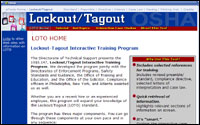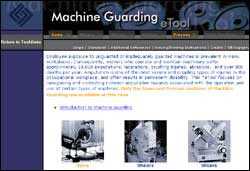 |
Plastics Industry |
|
| Hazards and Solutions |
|
|
|
Many workers are unaware of the potential hazards in their work environments,
making them more vulnerable to injury. The following references aid in recognizing and controlling
workplace hazards that may be present in the plastics industry.
General
Electrical
Ergonomics
-
Toolbox Tray 1: Looking for Signs of WMSDs. US Department of Health and Human Services (DHHS), National Institute for Occupational Safety and Health (NIOSH)
Publication No. 97-117 (Elements of Ergonomics Programs), (1997, March). Links
to NIOSH investigations where certain work settings were found to contribute to work-related
musculoskeletal disorders (WMSDs). Lists disorders and recommendations for avoiding injury. The following are relevant to the plastics industry:
- 3070: Manufacturing (Plastics, metal products)
- Bennett Industries, Peotone, Illinois.
National Institute for Occupational Safety and Health (NIOSH) Health Hazard Evaluation and Technical Assistance (HETA) Report
No. HETA 89–146–2049, (1990, June),
172 KB PDF,
20 pages.
- 3089: Manufacturing (Plastic products)
- Scott Molders, Inc., Kent, Ohio. National Institute for
Occupational Safety and Health (NIOSH) Health Hazard Evaluation and Technical Assistance (HETA)
Report No. HETA 91–0003–2232, (1992, July), 180 KB
PDF,
20 pages.
- Ergonomics
FAQs for Plastics Processors. Society of the Plastics Industry (SPI). Answers
commonly asked questions regarding ergonomics for plastic processors.
- For additional information, see OSHA's Ergonomics Safety and Health Topics Page.
Hazard Communication
Isocyanates
- A Summary of Health Hazard Evaluations: Issues Related to
Occupational Exposure to Isocyanates, 1989 to 2002. US Department of
Health and Human Services (DHHS), National Institute for Occupational Safety and Health (NIOSH) Publication No. 2004-116, (2004, January), 1 MB
PDF, 42 pages.
- TDI User Guidelines for Protective Clothing Selection. Alliance
for the Polyurethanes Industry (API) Technical Bulletin AX179, (2001, July), 126 KB
PDF,
6 pages. Presents guidelines for selecting the appropriate chemical protective clothing for working with
toluene diisocyanate (TDI) and TDI-based foam systems.
- PMDI User Guidelines for Protective Clothing Selection. Alliance for
the Polyurethanes Industry (API) Technical Bulletin AX178, (2002, January), 245 KB
PDF,
6 pages. Presents guidelines for selecting the appropriate personal protective equipment (PPE) for working
with methylene diphenyl diisocyanate (PMDI) and PMDI-based foam systems.
- For additional information, see OSHA's Isocyanates
Safety and Health Topics Page.
Legionnaires' Disease
Lockout/Tagout
-
Rollstock and Sheet Extrusion Machine Safety Training Course.
OSHA and the Society of the Plastics Industry, Inc. (SPI). Contains
machine-specific modules on machine guarding and lockout/tagout and helps to identify the
types of injuries that may occur while operating an extrusion molding machine and ways to avoid those injuries.
- Injection Molding Machine Safety Training Course.
OSHA and the Society of the Plastics Industry, Inc. (SPI). Contains
machine-specific modules on machine guarding and lockout/tagout and helps to identify the
types of injuries that may occur while operating an injection molding machine and ways to avoid those injuries.
- Roll-fed and Inline Thermoforming Machine Safety Training Course.
OSHA and the Society of the Plastics Industry, Inc. (SPI). Contains
machine-specific modules on machine guarding and lockout/tagout and helps to identify the
types of injuries that may occur while operating roll-fed and inline thermoforming machines.
 Lockout-Tagout Interactive Training Program.
OSHA eTool. Includes a tutorial that explains the Lockout/Tagout
standard in question and answer format, a list of Hot Topics
discussing major issues related to the standard, and seven
interactive case studies. Lockout-Tagout Interactive Training Program.
OSHA eTool. Includes a tutorial that explains the Lockout/Tagout
standard in question and answer format, a list of Hot Topics
discussing major issues related to the standard, and seven
interactive case studies.- NIOSH Alert: Preventing
Worker Deaths from Uncontrolled Release of Electrical, Mechanical, and Other Types of Hazardous Energy.
US Department of Health and Human Services (DHHS), National Institute
for Occupational Safety and Health (NIOSH) Publication No.
99-110, (1999, July). Provides steps to follow in order to protect yourself when installing or servicing equipment and systems.
- For additional information, see OSHA's Control
of Hazardous Energy (Lockout/Tagout) Safety and Health Topics Page.
Machine Guarding
-
Rollstock and Sheet Extrusion Machine Safety Training Course.
OSHA and the Society of the Plastics Industry, Inc. (SPI). Contains
machine-specific modules on machine guarding and lockout/tagout and helps to identify the
types of injuries that may occur while operating an extrusion molding machine and ways to avoid those injuries.
- Injection Molding Machine Safety Training Course.
OSHA and the Society of the Plastics Industry, Inc. (SPI). Contains
machine-specific modules on machine guarding and lockout/tagout and helps to identify the
types of injuries that may occur while operating an injection molding machine and ways to avoid those injuries.
- Roll-fed and Inline Thermoforming Machine Safety Training Course.
OSHA and the Society of the Plastics Industry, Inc. (SPI). Contains
machine-specific modules on machine guarding and lockout/tagout and helps to identify the
types of injuries that may occur while operating roll-fed and inline thermoforming machines.

- Machine Guarding.
OSHA eTool. Focuses on recognizing and controlling
common amputation hazards associated with the operation and use of
certain types of machines.
-
Plastics Machinery. Discusses guidelines and safety measures for
horizontal injection molding machines. A
virtual
tour of a horizontal injection molding machine is also available.
- Amputations. OSHA Fact Sheet, (2002), 153 KB
PDF*, 2 pages.
Covers where and how to avoid amputations.
-
Safeguarding Equipment and Protecting Workers from Amputations.
OSHA Publication 3170-02R, (2007). Also available as a 1 MB
PDF,
60 pages. Helps the small business employer identify and manage common amputation
hazards associated with operating and using stationary equipment.
- For additional information, see OSHA's Machine Guarding
Safety and Health Topics Page.
Noise
Personal Protective Equipment (PPE)
Powered Industrial Trucks
Respiratory Protection
Walking/Working Surfaces
- Slips and Falls Caused by Plastic Pellets and Beads
- Slips and falls are one of the major causes of plastics industry
accidents. They occur frequently and happen when you least expect it. Walking
surfaces that have spilled resin pellets or beads provide minimal traction due
to the slippery nature of the pellets or beads, and subject workers to slips
and falls. The occurrence of slips and falls and the extent of injuries from
them can be minimized through proper safety and good housekeeping practices.
It is important to identify and correct unsafe conditions to prevent slips and
falls from spilled resin pellets or beads. An all around program that will
help you is called "Operation
Clean Sweep". This free program shows you how to ensure that your worksite
is properly set up to prevent pellet loss and to assist you in cleaning up
your facility.
- For additional information, see OSHA's
Walking/Working Surfaces Safety and Health Topics Page.
*These files are provided for downloading.
|
|
|
|

